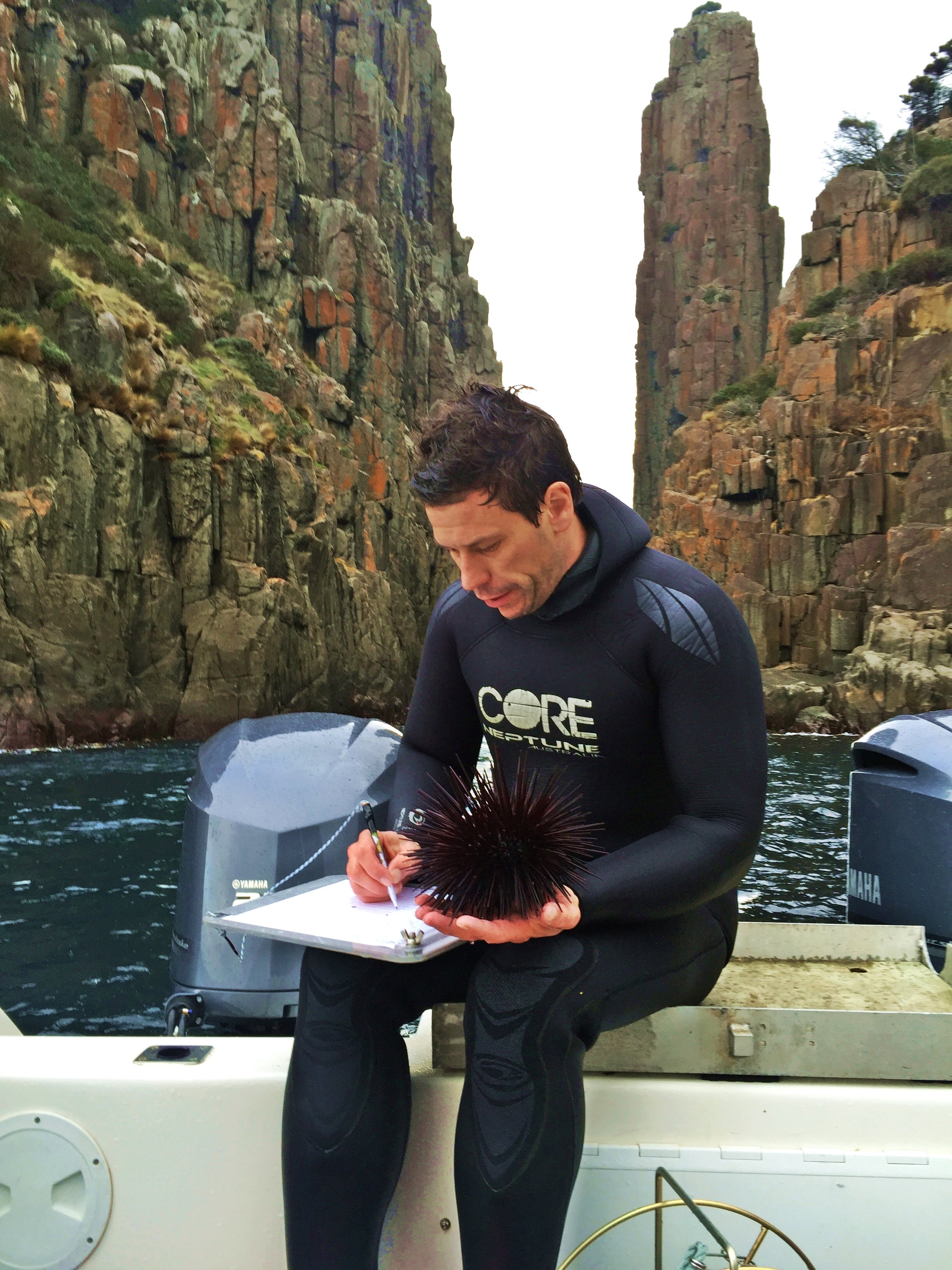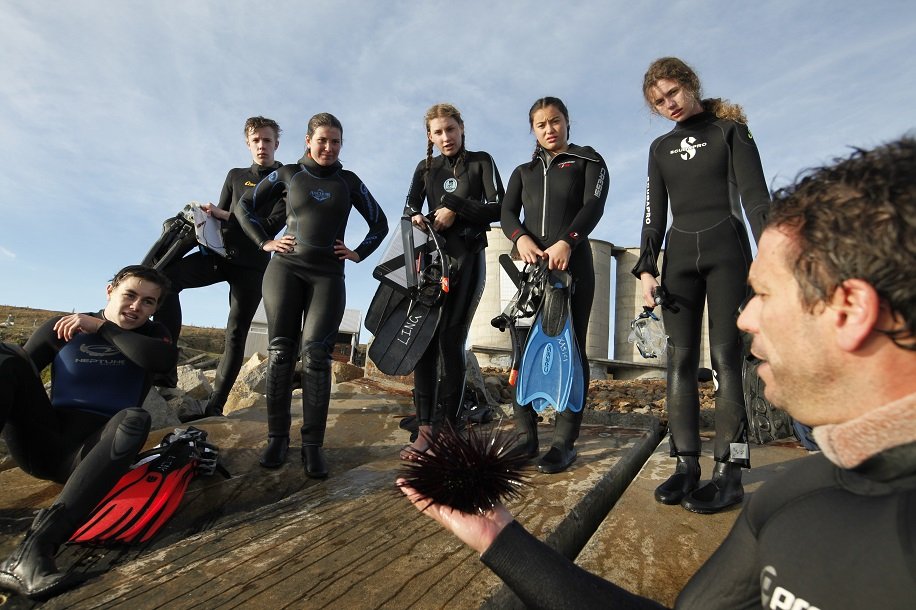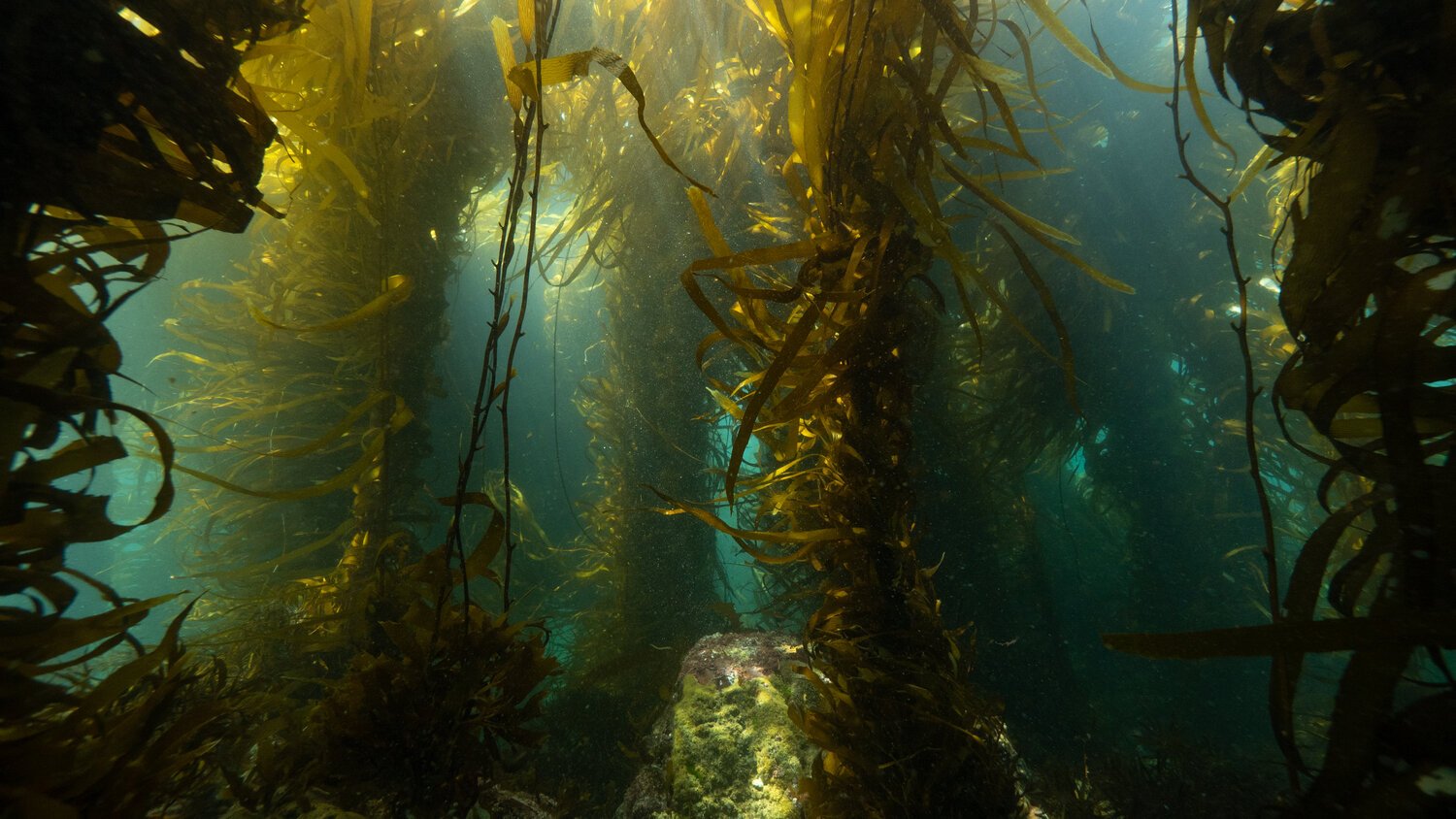ASSOC. PROF. scott linG
Revolutionising Strategies to Combat Urchins and Restore the Great Southern Reef
From Coastal Combi Trips to Groundbreaking Research
A lifelong passion often starts with a spark in childhood, and for Scott Ling, this spark ignited during family trips in a Combi van along Australia's stunning coastlines. Ling remembers these formative trips fondly, as they offered him a glimpse into the beauty and complexity of Australia's marine ecosystems and inspired his lifelong commitment to understanding and protecting these systems.
Embarking on coastal trips with his family, Ling found himself captivated by the endless diversity of marine life along Australia's stunning shorelines. He would spend hours identifying various fish species, each discovery further fuelling his fascination. Little did he know, these early encounters were sowing the seeds of a lifelong commitment to exploring the dynamics and food-webs underpinning reef ecosystems.
The Great Southern Reef: A Rich Ecosystem Under Threat
In the shadow of its more famous neighbour, the Great Barrier Reef, the GSR quietly thrives, providing a home for countless marine species and contributing significantly to Australia's fishing and tourism industries. Despite its economic and ecological significance, it remains largely overlooked, with mounting environmental challenges threatening its future.
Ling's work seeks to elevate the recognition of the Great Southern Reef's significance while addressing the environmental challenges it faces. His ongoing research, restoration work, and advocacy efforts underscore his commitment to preserving the reef's ecological integrity for generations to come.
One of the most pressing challenges is the rise of the long-spined sea urchin, Centrostephanus rodgersii, an invasive species whose unchecked population growth has led to the creation of 'urchin barrens' – areas where lush kelp forests once stood, now stripped bare. These barren landscapes represent a significant loss of habitat and biodiversity and signal the interruption of essential ecosystem functions.
These sea urchins, voracious consumers of kelp, are creating 'urchin barrens'—areas devoid of vegetation and left as desolate underwater deserts. The surge in urchin numbers is a complex puzzle that is strongly tied to warming ocean temperatures, the decline of natural urchin predators, and shifts in the reef's ecological equilibrium. Ling has been instrumental in investigating these complexities, a task that has led to innovative strategies to manage the issue.
An Urchin Problem Solver
Associate Professor Ling has been instrumental in discovering the complex factors contributing to the urchin problem, casting new light on how climate change, predatory interactions, and ecological balance play into the crisis. His pioneering research on urchin population dynamics and the resultant ecological impact have been a game-changer in understanding and identifying tangible management levers that can be pulled to help solve the urchin explosion.
Since 2001, Ling's ongoing research commitment to understanding urchin ecology across south-eastern Australia has meant his long-term observations and experimental results provide a key witness statement to the Urchin Senate Inquiry. He helped highlight the severity of the urchin issue and championed sustainable, effective solutions. "People are now growing in awareness of the sea urchin issue. And there's a growing awareness of some of the solutions to this problem," explains Ling, underscoring his commitment to raising awareness and promoting change.
One unforgettable eureka moment during his PhD research at Maria Island remains vivid in his memory. After placing urchins into the marine reserve, Ling observed large lobsters to come in and start consuming the urchins. "When I put those cameras out overnight and saw the lobsters coming in and consuming those urchins under infrared lighting —it was quite striking," Ling recalls. Immediately there was hope that something could be done about the urchin incursion.
This experience gave him crucial insight into the predatory-prey dynamics in a rapidly warming marine ecosystem, reinforcing the importance of naturally large and abundant predators in helping maintain balance and reducing risk of urchin overgrazing. In subsequent experiments he tested urchin survival on reefs inside marine reserves compared to reefs open to intensive fishing with few lobsters present, this research revealed that high abundances of large lobsters can help control urchin populations.
"When I put those cameras out overnight and saw the lobsters coming in and consuming those urchins under infrared lighting —it was quite striking,"
From Alarming Data to Action
Back in 2001, shortly after completing his honours research, Ling embarked on a groundbreaking endeavour to survey 156 sites along the Tasmanian east coast, focusing on counting the abundance of long-spined sea urchins and estimating the amount of grazing present. This ambitious undertaking aimed to assess the extent of the issue and monitor any changes that were already underway. Ling recalls, "This is where we first realised the full extent of the issue, and some of the changes were already well and truly underway."
Fast forward to 2016-2017, when Ling and his colleagues resurveyed the same sites. The results were alarming. "At that point, we could clearly see urchin populations had almost doubled and the amount of overgrazing on the coast had almost quadrupled over the 15-year period," explains Ling. The evidence of population increase and expanding barren grounds was undeniable, making it clear that action needed to be taken.
The breakthrough came in 2018 when the government swiftly responded to the resurvey results by establishing the Abalone Industry Reinvestment Fund, allocating $5 million to support on-ground incentives for removing urchins from the water. This development renewed Ling's confidence in the symbiotic relationship between science and management. "You can't manage if you can't measure it," Ling emphasises. Armed with the scientific data and measurements they had collected, Ling and his team presented the evidence to the managers, leaving no room for doubt. The urgency of the situation was recognised, was echoed loudly by the abalone fishers who were seeing it firsthand and proactive measures were implemented, including a harvest subsidy to promote urchin removal from the reef.
Trialled for the first time in 2009, a Tasmanian Centrostephanus urchin fishery was highly variable in the early years but with the harvest subsidy there has been a steady annual harvest of approximately 500 tonnes of urchins since 2019. By driving down the urchin numbers at local scales, the developing fishery has been a frontline weapon to pave the way for kelp recovery. Ling states, "It's heading in the right direction. There's still a really, really big challenge there."
Legislative Leaps: The Urchin Senate Inquiry
Recognising the urgency for a unified approach and policy intervention to address the urchin problem across southeast Australian States, Ling has contributed significantly to the Urchin Senate Inquiry into climate-related marine invasive species on the GSR. The inquiry sought to highlight the severity of the urchin crisis and push for timely, sustainable, and effective solutions.
"People are now growing awareness of the sea urchin issue. And there's a growing awareness of some of the management levers that can be pulled," Ling explains. Seeing the changes in his own backyard over the past 25-yrs, Ling’s long-term efforts along with that of fellow colleagues was summarised in the IMAS submission to The Inquiry which provided the scientific underpinnings required to make useful policy decisions.
Reviving Giants: The Path to Kelp Forest Restoration
Restoring the giant kelp forests of the Great Southern Reef has been a key focus of Ling's work. These once abundant underwater forests have suffered due to warming ocean temperatures and unchecked urchin predation.
The COVID-19 pandemic, while globally disruptive, offered Ling an unexpected opportunity. He was offered a large amount of twine seeded with juvenile giant kelp, which he used to design a large-scale experiment. This led Ling to pioneer successful underwater outplanting techniques that continue to be replicated and expanded to the forest-scale.
"I think we're seeing this transition to where people can actually be part of the solution," says Ling. This community-driven effort is about more than just restoration. It's about empowering communities to reclaim the health of their local marine ecosystems and helping them understand how vital they are in bringing back the once-majestic kelp forests. The community involvement doesn't stop at volunteering; Ling has also emphasised the potential for creating additional jobs for divers through the combination of urchin harvest and giant kelp outplanting to restore reef habitats and productivity over even larger areas.
A Fish Worthy of Respect
Through his extensive work on the Great Southern Reef, Associate Professor Ling has been privy to the rich diversity of life that populates this unique ecosystem. Among the countless species that call the GSR home, one stands out as his personal favourite—the Eastern Blue Groper.
This charismatic fish is a natural predator of the long-spined urchins, with large healthy populations of groper able to exert significant downward pressure on urchin populations. Ling's affection for the Blue Groper extends beyond its ecological role; he is enamoured by its curiosity and strength.
The Eastern Blue Groper, he says, "deserves anyone's respect." However, Ling also recognises the threats facing this essential predator, highlighting an important opportunity to achieve a natural reduction in urchin numbers by fully protecting the Blue Groper from line fishing in New South Wales.
According to Ling, the combined amount of urchins that could have been eaten by the Eastern Blue Gropers annually—had they not been removed from the ecosystem due to line fishing in NSW — could potentially approximate something like the weight of urchins harvested in the wild in Tasmania each year, which is around 500 tons and if sustained through time can lead to localised kelp recovery.
The Kent Group: Reef Ecosystems Collide
When asked about his favourite location on the Great Southern Reef, Ling immediately points to the Kent Group in Bass Strait. It is a special place where coral reef ecology and temperate reef ecology meet, providing a sneak peek into potential future scenarios under warming seas. It's also a remote area, hard to access, adding to its allure and mystery.
The Kent Group serves as a living laboratory for Ling and his colleagues, where they observe, study, and draw critical insights into the complex interactions within reef ecosystems. As Ling puts it, "It's a little window into understanding some of the broader changes to reef ecosystems as the oceans warm, The Kent Group is a super interesting melting-pot of species interactions."
Ling’s Legacy: Nurturing the Next Generation of Marine Scientists
A significant aspect of Ling's legacy is his dedication to nurturing the next generation of marine scientists. Every year, he mentors a group of year 11-12 students to Maria Island for a week-long immersive marine biology pre-degree program with IMAS/UTAS. The students are trained-up in species identification and sampling skills to collect data on the diversity of reef fishes, zooplankton, infauna and intertidal organisms.
A key focus is on identifying those warmer-water species that have made their way south to Tasmania, over the almost 10-yrs of the monitoring program increases in these range-extending species are being observed in the waters of Maria Island which sits within a global hotspot of ocean warming. "Being able to undertake sampling, identifying species, and analysing the monitoring data and seeing the changes...that's really empowering for the students," says Ling. The aim is to light the same spark of fascination he felt as an undergraduate at UTAS, inspiring the next generation to take up the mantle of marine conservation.
The Great Southern Reef Research Partnership: Uniting Forces for Conservation
The Great Southern Reef Research Partnership, a newly-formed collaboration between universities, management agencies, and NGOs from across Australia, is taking a whole-of-system approach to safeguard the critical functions, fisheries, and biodiversity of the Great Southern Reef. Funded largely by the Ian Potter Foundation, the partnership aims to increase public understanding of the reef's existence, importance, and scientific understanding of how it is changing.
Reflecting on the importance of collaboration, Ling emphasises, "The Great Southern Reef Research Partnership is about bringing together scientists, managers, industry, and communities to address the complex challenges facing our marine ecosystems." This collective approach allows for a more comprehensive understanding of the reef's dynamics, ensuring that research findings translate into practical conservation strategies.
Ling firmly believes that collaboration is the key to success in addressing the environmental challenges facing the Great Southern Reef. He states, "No one person or organisation can tackle the vast scale of these issues alone. It requires a united effort, drawing upon the expertise and resources of diverse stakeholders."
Through collaboration and shared goals, the research partnership is creating a platform for innovative ideas and cross-disciplinary approaches. Ling concludes, "The Great Southern Reef Research Partnership provides a framework for combining scientific research, community engagement, and industry involvement. Together, I feel we can achieve a sustainable future for this magnificently diverse and productive marine ecosystem."
"No one person or organisation can tackle the vast scale of these issues alone. It requires a united effort, drawing upon the expertise and resources of diverse stakeholders."
The Future of the Great Southern Reef
Looking ahead, Ling envisions a future where the Great Southern Reef is in 'good hands.' It is about nurturing those passionate about preserving this unique ecosystem and developing champions for the GSR. In his words, "Not one person can do this, it needs to be in good hands and many hands that are pulling in the right direction."
While the challenges facing the GSR are vast, so too is the passion, resilience, and commitment of scientists like Scott Ling and the burgeoning generation of marine ecologists he is helping to shape. His career, underpinned by his tireless research and advocacy, exemplifies the power of passion, curiosity, and determination in championing for environmental change. His story reminds us that our lifelong passions can pave the way to meaningful, impactful careers—and in the process, promote a brighter future for our kelp forest ecosystems.

















